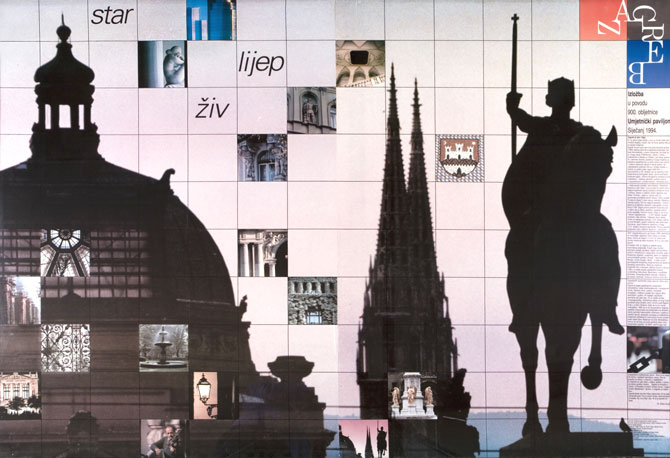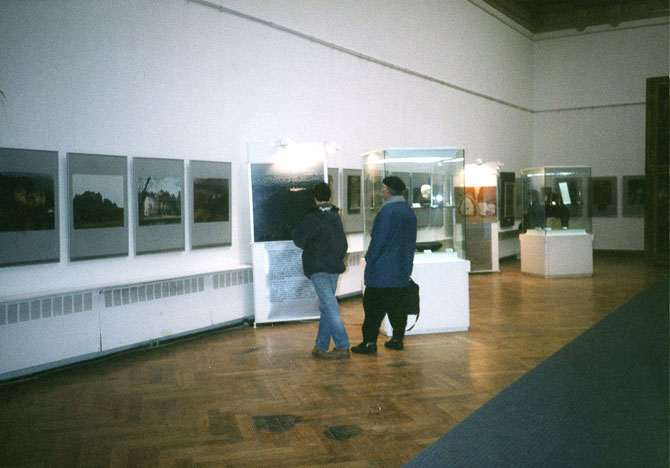The City of Zagreb and Zagreb City Museum, guest appearance in Art Pavilion in Zagreb
Exhibition concept: Željka Čorak, Slavko Dakić, Mihajlo Kranjc, Nada Premerl, Snješka Knežević
Exhibition design: Mihajlo Kranjc
Poster design: Boris Ljubičić

Zagreb was mentioned for the first time in the decree of the archbishop of Esztergom Felicianus, dated 1134, ruling that the bishop of Zagreb, Marcelin, was to be given the forest in Dubrava, which had been granted by the Hungarian king Ladislaus, thus in effect founding the Zagreb diocese. The first bishop was Duh, a Slovak, and historians infer that the Zagreb diocese was founded in 1094. That proves that there was a large (pre-Romanesque or early Romanesque) church in Kaptol; there must have also existed a substantial settlement, an important center of traffic and commerce, since dioceses were not founded in villages or small towns.
In 1994, ninehundred years will have passed since the Zagreb diocese was founded, and the City of Zagreb will celebrate the 900th anniversary of the first written reference to its name.
In the days of the Roman Empire towns in the province of Western Pannonia were built along the banks of the river Sava. Sisak (Roman Siscia) was the capital, and Andautonia was built where greater Zagreb is today (Ščitarjevo archeological site). In the Middle Ages, the habitations were moved to the higher ground, for security reasons. After the Croats settled in the region, the life went on on the two hills at the foot of the Medvednica mountain. The “twin towns”, Gradec, with its artisans and merchants and the diocesan Kaptol, were built on the two hills. The birth of the medieval “twin town” Zagreb is not recorded in the annals, the founding of the Zagreb diocese in 1094 could have only taken place after several centuries of city's existence. As we celebrate its 900th birthday, we know that Zagreb is much older...
In the 1242 Golden Bull, Gradec was granted the status of a Free Royal City. The document granted it the right to build fortifications, to hold fairs, to engage in trade... The late Gothic church of St. Mark's was built in its center; two monasteries followed during the Baroque period, as well as the magnificent church of St Catherine, numerous palaces of the aristocracy, houses of tradesmen and merchants. In 1607 the Gymnasium was built and in 1669, Zagreb University came into being. Kaptol also bears the mark of the passing years: the Renaissance fortifications around the Cathedral bears witness to the Turkish menace of the 16th century, when Zagreb and Croatia took upon themselves the role of “the bulwark of Christendom” (Antemurale Christianitatis). The canonical residences bear witness to the prosperity of the Baroque period. After the Tatars destroyed the original building, the Gothic Cathedral was rebuilt and expanded from the 13th century on; now, with its twin towers, it is the symbol of the city.
In the 19th century, the age of Romanticism, Zagreb was the center of the Illyrian movement and Croatian national revival, and hence the center of all arts (opera, drama, novel, poetry, painting, sculpture...). Later on, Zagreb assumed the central role in the development of modern political thought and action. In brief, Zagreb became the Croatian metropolis in every sense. The foundations were laid in 1557, when Zagreb was recognized as the metropolis of the kingdoms of Dalmatia, Croatia and Slavonia. As the most developed urban center in southeastern Europe, it became the cultural and scientific metropolis of the South Slavic peoples (The Yugoslav Academy of Arts and Sciences was established in 1860). Only in 1850 did Gradec and Kaptol merge with Vlaska street, Nova Ves and other communities into one single city of Zagreb. The Lower Town began to flourish, expanding South to the railway line. Its monumental buildings (Croatian National Theater, Croatian Academy of Arts and Sciences, the Arts pavilion), in the string of parks which formed the so-called green horseshoe, are a great architectural achievement in European terms, as is Maksimir Park and Mirogoj Cemetery, one of the most beautiful cemeteries in Europe.
After the “twin towns” and the Lower Town, the third Zagreb has developed in the 20th century, south of the railway lines and the Sava River. In Croatia, Zagreb has become the major center of industry and trade, business (The International Trade Fair is held here) transportation, and information... Major scientific and cultural institutions are located in Zagreb – the University, the National Library, the Croatian Academy of Arts and Sciences, the Croatian Cultural Society, the Institute of Lexicography, Rudjer Bošković Institute, and others...
Twentieth century Zagreb has been home to a hundred-odd artists of European renown, the Zagreb School of Modern Architecture (in the thirties), the first abstract group in the “Eastern bloc” (EXAT 51), the Zagreb School of Animation (which won an Oscar in 1961), the International Music Biennial, the Animated Film Festival (“Z is for Zagreb”), the Graphic Design Biennial, and the Ceramics Triennial...
Zagreb is a place where philosophers, people of various creative gifts are born, the place they come to from all over Croatia. Their names are among the greatest names of Europe and the world: Nobel Prize winners, Ružička and Prelog; writers A. G. Matoš, M. Krleža and T. Ujević, to name but a few; the ingenious inventor Penkala, D. Petrović, the basketball star; Croatian football, basketball, handball, water polo, tennis...
Zagreb has managed to keep alive the political flame of the historical continuity of Croatia – especially in Croatian Parliament, the Sabor – and now, on the eve of its 900th birthday, Croatia has achieved its independence and full sovereignty.
Radovan Ivančević
Pictures from the exhibition






